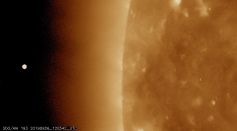Tags: Mercury
The Planet Mercury Passes Across The Sun

Marine Fog Endangers Mountain Lions with High Concentration of Mercury

Brace Yourselves: Mercury is Here
Researchers Found a Nanomaterial to Replace Mercury
Mercury's Solid Metal Core Could Give a Glimpse into the Earth's Future
Mercury Levels Up In Women Of Childbearing Age In Asia Pacific Region Alarms Global Community
Planet Mercury Shall Be Visible This March 2017
Scientists Indentify One Factor Of Having ALS Or Lou Gehrig’s Disease – Eating Seafood With High Mercury Content
Gluten Free Foods Can Increase Risk Of Toxic Metal Exposures
Five-Planet Alignment To Light Up The Morning Sky
Getting to the Core of MESSENGER's Research—Mercury Reveals A Liquid Core
Data from NASA’s Messenger Probe Reveals New Information About Mercury’s Magnetic Field
A Final Scene from Mercury—MESSENGER’s Last View
NASA’s Messenger Mission Comes to an End As Probe Crashes into Mercury’s Surface
Messenger Prepares to Dive Bomb Mercury
Messenger Probes Dramatic Death Scheduled for April 30
NASA Set to Extend Mercury Mission for Another Month
New NASA Maps Reveal Secrets of Mercury
NASA Receives Proposals for More Solar System Exploration
The Fishy Case of How Seafood May Help Fetuses In-Utero
Most Popular

Viruses vs Bacteria: Key Differences, How They Spread, and How We Treat Them

How Ice Cores Reveal Climate History: Insights from Paleoclimate Science and Ancient Data

Science-Backed Longevity Supplements: The Best Anti-Aging Vitamins for Powerful Healthy Aging Support

Carbon Footprint 101: What It Is and Simple Ways to Reduce Yours




